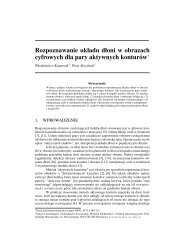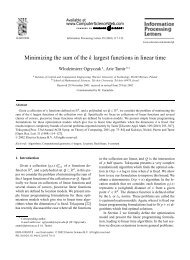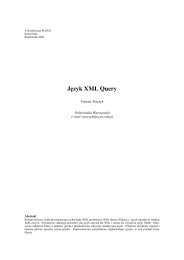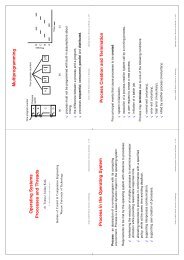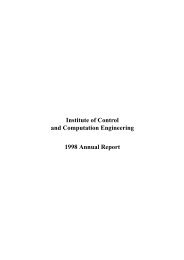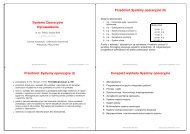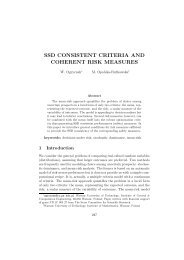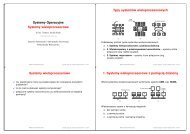Efficient Portfolio Optimization with Conditional Value at Risk
Efficient Portfolio Optimization with Conditional Value at Risk
Efficient Portfolio Optimization with Conditional Value at Risk
Create successful ePaper yourself
Turn your PDF publications into a flip-book with our unique Google optimized e-Paper software.
904 PROCEEDINGS OF THE IMCSIT. VOLUME 5, 2010<strong>with</strong> the inner optimiz<strong>at</strong>ion problemD(u) = maxx j{T∑ ∑nu t r jt x j :t=1j=1n∑µ j x j ≥ µ 0 ,j=1n∑x j = 1,j=1x j ≥ 0, j = 1,...,n}n∑ T∑= max { ( r jt u t )x j :x jj=1t=1n∑µ j x j ≥ µ 0 ,j=1n∑x j = 1,j=1x j ≥ 0, j = 1,...,n}.(11)Again, we may take advantages of the LP dual to the innerproblem. Indeed, introducing dual variable q corresponding tothe equ<strong>at</strong>ion ∑ nj=1 x j = 1 and variable u 0 corresponding tothe inequality ∑ nj=1 µ jx j ≥ µ 0 we get the LP dualD(u) = minq,u 0{q −µ 0 u 0 :q −µ j u 0 −T∑r jt u t ≥ 0 j = 1,...,n}.t=1Hence, an altern<strong>at</strong>ive model for the CVaR portfolio optimiz<strong>at</strong>ion(10) can be expressed as the following LP:min q −µ 0 u 0s.t. q −µ j u 0 −T∑r jt u t ≥ 0, j = 1,...,nt=1T∑(12)u t = 1t=10 ≤ u t ≤ p tβ , t = 1,...,TLP model (12) contains T + 1 variables u t , but the Tconstraints corresponding to variables d t from (6) take theform of simple upper bounds on u t (for t = 1,...,T)thus not affecting the problem complexity. The number ofconstraints in (12) is proportional to the total of portfoliosize n, thus it is independent from the number of scenarios.Exactly, there are T +1 variables and n+1 constraints. Thisguarantees a high comput<strong>at</strong>ional efficiency of the model evenfor very large number of scenarios. Similarly, other portfoliostructure requirements are modeled <strong>with</strong> r<strong>at</strong>her small numberof constraints thus gener<strong>at</strong>ing small number of additionalvariables in the model. Actually, the model (12) is the LPdual to the model (6), thus similar to th<strong>at</strong> introduced in [23].Obviously, the optimal portfolio shares x j are not directlyrepresented<strong>with</strong>inthe solutionvectorofproblem(12)buttheyare easily available as the dual variables (shadow prices) forinequalities q −µ j u 0 − ∑ Tt=1 r jtu t ≥ 0.The Minimax portfolio optimiz<strong>at</strong>ion model can be writtenas the following LP problem:max ηn∑s.t. µ j x j ≥ µ 0 ,j=1n∑x j = 1j=1x j ≥ 0, j = 1,...,nn∑−η + r jt x j ≥ 0, t = 1,...,Tj=1(13)which is simpler than the standard CVaR optimiz<strong>at</strong>ion model(6). Except from the portfolio weights x j , the model containsonly one additional variable η. Nevertheless, it still contains Tlinear inequalities in addition to the core constraints. Hence,its dimensionality is (T +2)×(n+1).The Minimax portfolio optimiz<strong>at</strong>ion model representing alimiting case of the CVaR model for β tending to 0. Actually,for any β ≤ min t=1,...,T p t we gets M β (x) = M(x) thusallowing to represent the Minimax portfolio optimiz<strong>at</strong>ion bythe CVaR optimiz<strong>at</strong>ion model (6) and to take advantagesof itsdual form (12). Due to β ≤ p t for all t = 1,...,T, the upperbounds on variables u t becomes redundant and we get thefollowing dual form of the Minimax portfolio optimiz<strong>at</strong>ion:min q −µ 0 u 0s.t. q −µ j u 0 −T∑u t = 1t=1T∑r jt u t ≥ 0, j = 1,...,nt=1u t ≥ 0, t = 1,...,T(14)The model dimensionality is only (n + 1) × (T + 2) thusguaranteeing a high comput<strong>at</strong>ional efficiency even for verylarge number of scenarios.The Mean Absolute Devi<strong>at</strong>ion (MAD) risk measure isdirectly given by the value of the second order cdf F x(2) <strong>at</strong>the mean ¯δ(x) = E{max{µ(x)−R x ,0}} = F x (2) (µ(x)) [19].Therefore,its leadstoan LP portfoliooptimiz<strong>at</strong>ionmodelverysimilar to th<strong>at</strong> for the CVaR optimiz<strong>at</strong>ion (6). Indeed, we get:max −s.t.T∑p t d tt=1n∑µ j x j ≥ µ 0 ,j=1d t ≥n∑x j = 1j=1n∑(µ j −r jt )x j , d t ≥ 0, t = 1,...,Tj=1x j ≥ 0, j = 1,...,n(15)<strong>with</strong> T+n variablesand T+2 constraints. The LP dual model
WLODZIMIERZ OGRYCZAK, TOMASZ SLIWINSKI: EFFICIENT PORTFOLIO OPTIMIZATION WITH CONDITIONAL VALUE AT RISK 905TABLE ICOMPUTATIONAL TIMES (IN SECONDS) FOR THE STANDARD MEAN-RISK MODELSScenarios Securities CVaR (6) Minimax MAD(T) (n) β = 0.05 β = 0.1 β = 0.2 β = 0.3 β = 0.4 β = 0.5 (13) (15)5 000 76 2.5 2.6 3.7 5.2 6.7 7.6 0.5 19.07 000 76 4.1 4.4 6.9 9.3 11.8 14.8 0.9 9.310 000 76 6.5 8.3 13.9 18.4 24.2 29.8 1.3 18.450 000 50 3275.4 4876.6 – – – – 7.8 –50 000 100 – – – – – – 24.1 –TABLE IICOMPUTATIONAL TIMES (IN SECONDS) FOR THE DUAL MEAN-RISK MODELSScenarios Securities CVaR (12) Minimax MAD(T) (n) β = 0.05 β = 0.1 β = 0.2 β = 0.3 β = 0.4 β = 0.5 (14) (16)5 000 76 0.9 0.9 1.1 1.3 1.4 1.6 0.5 2.17 000 76 1.2 1.4 1.8 2.0 2.2 2.3 0.7 3.110 000 76 2.0 2.3 2.9 3.4 3.9 4.0 1.0 10.850 000 50 14.9 19.4 24.0 26.8 28.2 27.9 3.9 25.850 000 100 40.0 54.6 68.7 77.7 78.2 78.8 8.2 76.7takes then the form:min q −µ 0 u 0s.t. q ≥ µ j u 0 −T∑(µ j −r jt )u t , j = 1,...,nt=10 ≤ u t ≤ p t , t = 1,...,T(16)<strong>with</strong> dimensionality n × (T + 2). Hence, there is againguaranteed the high comput<strong>at</strong>ional efficiency even for verylarge number of scenarios.Wehaveruntwogroupsofcomput<strong>at</strong>ionaltests.Themediumscale tests of 5 000, 7 000 and 10 000 scenarios and 76securities were gener<strong>at</strong>ed following the FTSE 100 rel<strong>at</strong>ed d<strong>at</strong>a[5]. The large scale tests instances developed by Lim et al.[9] were gener<strong>at</strong>ed from a multivari<strong>at</strong>e normal distribution for50 or 100 securities <strong>with</strong> the number of scenarios 50 000just providing an adequ<strong>at</strong>e approxim<strong>at</strong>ion to the underlyingunknown continuous price distribution. When applying thelower bound on the required expected return, its value µ 0was defined as the expected return of the portfolio <strong>with</strong> equalweights (market value). All comput<strong>at</strong>ions were performed ona PC <strong>with</strong> the Pentium 4 2.6GHz processor and 3GB RAMemploying the simplex code of the CPLEX 9.1 package.In Tables I and II there are presented comput<strong>at</strong>ion times forall the above primal and dual models. All results are presentedas the averages of 10 different test instances of the same size.For the medium scale test problems the solution times of thedualCVaRmodels(12)rangingfrom0.9to4.0secondsarenotmuch shorter than those for the primal models ranging from2.5 to 29.8seconds, respectively.However,an <strong>at</strong>tempt to solvetheprimalCVaRmodel(6)ofthelargescaletestproblemswassuccessful only for β = 0.05 and β = 0.1 and the times weredram<strong>at</strong>ically longer than those for the dual model. For othervalues of β the timeout of 6000 seconds occurred (marked<strong>with</strong> ’–’).For 100securitiesthe primalmodelwasnot solvable<strong>with</strong>in the given time limit, while the dual models could besuccessfully solved in 40.0 to 78.8 seconds.The Minimax models are comput<strong>at</strong>ionally very easy. Runningthecomput<strong>at</strong>ionaltestswe were ableto solvethe mediumscale test instances of the dual model (14) in times below 1second and the large scale test instances in up to 8.2 secondson average. In fact, even the primal model could be solved inreasonable time between 0.5 and 24 seconds, for medium andlarge scale test instances, respectively.The MAD models are comput<strong>at</strong>ionally similar to the CVaRmodels.Indeed,onlymediumscale test instancesofthe primalmodel (15) could be solved <strong>with</strong>in the given time limit. Muchshorter computing times could be achieved for the dual MADmodel(16)– not morethan 10.8secondsfor the mediumscaleand 76.7 seconds for the large scale test instances.To see how the value of the required expected return affectsthe solution times we have performed additional tests for thereformul<strong>at</strong>ed CVaR (<strong>with</strong> β = 0.1) and Minimax models<strong>with</strong> increased value µ 0 . The increased value was set in themiddle between the expected return of the market value andthe maximum possible return for single security portfolio.The comput<strong>at</strong>ional times are generally comparable <strong>with</strong> thosefor the market value constraints. Actually, for the mediumscale problems (10000 scenarios) the CVaR optimiz<strong>at</strong>ion timehas remained unchanged (2.3 seconds) while the Minimaxoptimiz<strong>at</strong>ion time has only raised from 1.0 to 1.1 secondsand for the MAD model optimiz<strong>at</strong>ion it has raised from 10.8to 13.9. For the large scale problems (50000 scenarios) wehave noticed even a drop in comput<strong>at</strong>ion times for the CVaRmodel (reduction from 54.6 to 49.9 seconds) and similarreduction (from 76.7 to 55.4 seconds) has occured for theMAD model optimiz<strong>at</strong>ion while the Minimax optimiz<strong>at</strong>iontime has increased from 8.2 to 10.5 seconds.IV. GINI’S MEAN DIFFERENCE AND RELATED MODELSYitzhaki [32] introduced the portfolio optimiz<strong>at</strong>ion modelusing Gini’s mean difference ∫ ∫ (GMD) as risk measure. TheGMD is given as Γ(x) = 1 2 |η−ξ|dFx (η)dF x (ξ) althoughseveral altern<strong>at</strong>ive formulae exist. For a discrete random vari-
906 PROCEEDINGS OF THE IMCSIT. VOLUME 5, 2010able represented by its realiz<strong>at</strong>ions y t , the measureΓ(x) =T∑∑t ′ =1t ′′ ≠t ′ −1max{y t ′ −y t ′′,0}p t ′p t ′′is LP computable (when minimized) leading to the followingportfolio optimiz<strong>at</strong>ion model:max −s.t.T∑t=1∑p t p t ′d tt ′t ′ ≠tn∑µ j x j ≥ µ 0 ,j=1d tt ′ ≥n∑r jt x j −j=1n∑x j = 1j=1n∑r jt ′x jj=1d tt ′ ≥ 0, t ≠ t ′ = 1,...,Tx j ≥ 0, j = 1,...,n(17)which contains T(T − 1) nonneg<strong>at</strong>ive variables d tt ′ andT(T −1) inequalities to define them. This gener<strong>at</strong>es a hugeLP problemeven forthe historical d<strong>at</strong>a case where the numberof scenarios is 100 or 200. Krzemienowski and Ogryczak [7]have shown <strong>with</strong> the earlier experiments th<strong>at</strong> the CPU time of7 seconds on average for T = 52 has increased to above30 sec. <strong>with</strong> T = 104 and even more than 180 sec. forT = 156. However, similar to the CVaR models, variablesd tt ′ are associ<strong>at</strong>ed <strong>with</strong> the singleton coefficient columns.Hence, while solving the dual instead of the original primal,the corresponding dual constraints take the form of simpleupper bounds (SUB) which are handled implicitly outside theLP m<strong>at</strong>rix. For the simplest form of the feasible set (1) thedual GMD model takes the following form:minq −µ 0 u 0T∑ ∑q ≥ µ j u 0 + (r jt −r jt ′)u tt ′, j = 1,...,n (18)t=1 t ′ ≠t0 ≤ u tt ′ ≤ p t p t ′, t,t ′ = 1,...,T;t ≠ t ′where original portfolio variables x j are dual prices to theinequalities. The dual model contains T(T −1) variables u tt ′but the number of constraints (excluding the SUB structure)n+1 is proportional to the number of securities. The abovedual formul<strong>at</strong>ion can be further simplified by introducingvariables:ū tt ′ = u tt ′ −u t′ t, t,t ′ = 1,...,T;t < t ′ (19)which allows us to reduce the number of variables to T(T −1)/2 by replacing (18) <strong>with</strong> the following:minq −µ 0 u 0T∑ ∑q ≥ µ j u 0 + (r jt −r jt ′)ū tt ′, j = 1,...,nt=1 t ′ >t−p t p t ′ ≤ ū tt ′ ≤ p t p t ′, t < t ′ = 1,...,T(20)Such a dual approachmay dram<strong>at</strong>ically improvethe LP modelefficiency in the case of larger number of scenarios. Actually,as shown <strong>with</strong> the earlier experiments of [7], the above dualformul<strong>at</strong>ions let us to reduce the optimiz<strong>at</strong>ion time below 10seconds for T = 104 and T = 156. Nevertheless, the case ofreally large numberof scenariosstill may cause comput<strong>at</strong>ionaldifficulties, due to huge number of variables (T(T − 1)/2).This may require some column gener<strong>at</strong>ion techniques [3] ornondifferentiable optimiz<strong>at</strong>ion algorithms [9].As shown by Yitzhaki [32] for the SSD consistency ofthe GMD model one needs to maximize the complementarymeasureµ Γ (x) = µ(x)−Γ(x) = E{R x ∧R x } (21)where the cumul<strong>at</strong>ive distribution function of R x ∧ R x forany η ∈ R is given as F x (η)(2−F x (η)). Hence, (21) is theexpect<strong>at</strong>ion of the minimum of two independent identicallydistributed random variables (i.i.d.r.v.) R x thus representingthe mean worse return. This provides us <strong>with</strong> another LPmodel although it is not more compact than th<strong>at</strong> of (17) andits dual (18). Altern<strong>at</strong>ively, the GMD may be expressed <strong>with</strong>integral of the absolute Lorenz curve asand respectivelyµ Γ (x) = 2Γ(x) = 2∫ 10= 2∫ 1∫010(αµ(x)−F (−2)x(α))dαα(µ(x)−M α (x))dαF (−2)x (α)dα = 2∫ 10αM α (x)dα (22)thus combining all the CVaR measures. In order to enrich themodeling capabilities, one may tre<strong>at</strong> differently some more orless extreme events. In order to model downside risk aversion,instead of the Gini’s mean difference, the tail Gini’s measureintroduced by Ogryczak and Ruszczyński [21], [20] can beused:µ Γβ (x) = µ(x)− 2 ∫ββ 2= 2∫β 2 β00F x(−2) (α)dα(µ(x)α−F x(−2) (α))dα(23)In the simplest case of equally probable T scenarios <strong>with</strong>p t = 1/T (historical d<strong>at</strong>a for T periods), the tail Gini’smeasureforβ = K/T maybe expressedasthe weightedcombin<strong>at</strong>ionof CVaRs M βk (x) <strong>with</strong> tolerance levels β k = k/Tfor k = 1,2,...,K and properly defined weights [21]. In ageneral case, we may resort to an approxim<strong>at</strong>ion based onsome reasonably chosen grid β k , k = 1,...,m and weightsw k expressing the correspondingtrapezoidal approxim<strong>at</strong>ionofthe integral in the formula (23). Exactly, for any 0 < β ≤ 1,while using the grid of m tolerance levels 0 < β 1 < ...
WLODZIMIERZ OGRYCZAK, TOMASZ SLIWINSKI: EFFICIENT PORTFOLIO OPTIMIZATION WITH CONDITIONAL VALUE AT RISK 907where β 0 = 0. This leads us to the Weighted CVaR (WCVaR)measure [12] defined asM (m)m w (x) = ∑w k M βk (x)k=1m∑w k = 1, w k > 0, k = 1,...,mk=1(25)We emphasize th<strong>at</strong> despite being only an approxim<strong>at</strong>ionto (23), any WCVaR measure itself is a well defined LPcomputable measure <strong>with</strong> guaranteed SSD consistency andcoherency, as a combin<strong>at</strong>ion of the CVaR measures. Hence,it needs not to be built on a very dense grid to provide propermodeling of risk averse preferences. While analyzed on thereal-life d<strong>at</strong>a from the Milan Stock Exchange the weightedCVaR models have usually performed better than the GMDitself, the Minimax or the extremal CVaR models [12].Here we analyze only comput<strong>at</strong>ional efficiency of the LPmodels representing the WCVaR portfolio optimiz<strong>at</strong>ion. Forreturns represented by their realiz<strong>at</strong>ions we get the followingLP optimiz<strong>at</strong>ion problem:maxs.t.m∑ m∑ w k∑Tw k η k − p t d tkβ kk=1 k=1 t=1n∑ n∑µ j x j ≥ µ 0 , x j = 1j=1j=1x j ≥ 0, j = 1,...,nn∑d tk ≥ η k − r jt x jj=1d tk ≥ 0, t = 1,...,T;k = 1,...,m(26)where η k (for k = 1,...,m) are unbounded variables takingthe values of the corresponding β k -quantiles (in the optimalsolution). The problem dimensionality is proportional to thenumber of scenarios T and to the number of tolerance levelsm. Exactly, the LP model contains m×T +n variables andm × T + 2 constraints. The LP problem structure is similarto th<strong>at</strong> of reperesenting the so-called WOWA optimiz<strong>at</strong>ion infuzzy approaches [22]. It does not cause any comput<strong>at</strong>ionaldifficulties for a few hundreds scenarios and a few tolerancelevels, as in a simple comput<strong>at</strong>ional analysis based on historicald<strong>at</strong>a [12]. However, in the case of more advancedsimul<strong>at</strong>ion models employed for scenario gener<strong>at</strong>ion one mayget several thousands scenarios. This may lead to the LPmodel (26)<strong>with</strong> hugenumberof variablesand constraintsthusdecreasing the comput<strong>at</strong>ional efficiency of the model. If thecore portfolio constraints contain only linear rel<strong>at</strong>ions, like(1), then the comput<strong>at</strong>ional efficiency can easily be achievedby taking advantages of the LP dual to model (26). The LPdual model takes the following form:min q −µ 0 u 0s.t. q −µ j u 0 −T∑u tk = w kt=1T∑ ∑mr jt u tk ≥ 0, j = 1,...,nt=1k=10 ≤ u tk ≤ p tw kβ k, t = 1,...,T;k = 1,...,m(27)th<strong>at</strong> contains m×T variables u tk , but the m×T constraintscorresponding to variables d tk from (26) take the form ofsimple upper bounds on u tk thus not affecting the problemcomplexity. Hence, again the number of constraints in (27) isproportional to the total of portfolio size n and the number oftolerance levels m, thus it is independent from the number ofscenarios. Exactly, there are m×T +2 variables and m+nconstraints thus guaranteeing a high comput<strong>at</strong>ional efficiencyof for very large number of scenarios.TABLE IIICOMPUTATIONAL TIMES (IN SECONDS) FOR THE DUAL WCVAR MODELSScenarios Securities Model (27)(T) (n) m = 3 m = 55 000 76 6.2 13.87 000 76 10.0 22.810 000 76 16.2 37.750 000 50 121.8 281.050 000 100 335.3 731.7We have tested comput<strong>at</strong>ional efficiency of the dual model(27) using the same randomly gener<strong>at</strong>ed test instances as fortesting of the CVaR and other basic models in Section III.Table III presents average comput<strong>at</strong>ion times of the dualmodels for m = 3 <strong>with</strong> tolerance levels β 1 = 0.1, β 2 = 0.25,β 3 = 0.5 and weights w 1 = 0.1, w 2 = 0.4 and w 3 = 0.5, thusrepresenting the parameters leading to good results on reallife d<strong>at</strong>a [12], as well as for m = 5 <strong>with</strong> uniformly distributedtolerance levels β 1 = 0.1, β 2 = 0.2, β 3 = 0.3, β 4 = 0.4,β 5 = 0.5 and weights (24).V. CONCLUDING REMARKSThe classical Markowitz model uses the variance as therisk measure, thus resulting in a quadr<strong>at</strong>ic optimiz<strong>at</strong>ion problem.There were introduced several altern<strong>at</strong>ive risk measureswhich are comput<strong>at</strong>ionally <strong>at</strong>tractive as (for discrete randomvariables) they result in solving linear programming (LP)problems.TheLP solvabilityisveryimportantforapplic<strong>at</strong>ionsto real-life financial decisionswhere the constructed portfolioshave to meet numerous side constraints and take into accounttransactioncosts.AgamutofLPcomputableriskmeasureshasbeenpresentedin the portfoliooptimiz<strong>at</strong>ionliter<strong>at</strong>urealthoughmost of them are rel<strong>at</strong>ed to the absolute Lorenz curve andthereby the CVaR measures. We have shown th<strong>at</strong> all the riskmeasures used in the LP solvable portfolio optimiz<strong>at</strong>ion modelscan be derived from the SSD shortfall criteria. This allowsus to guarantee their SSD consistency for any distribution ofoutcomes.
908 PROCEEDINGS OF THE IMCSIT. VOLUME 5, 2010The corresponding portfolio optimiz<strong>at</strong>ion models can besolved <strong>with</strong> general purpose LP solvers. However, in the caseof more advanced simul<strong>at</strong>ion models employed for scenariogener<strong>at</strong>ion one may get several thousands of scenarios. Thismay lead to the LP model <strong>with</strong> huge number of variablesand constraints thus decreasing the comput<strong>at</strong>ional efficiencyof the models. For the CVaR model, the number of constraints(m<strong>at</strong>rixrows)is proportionaltothe numberof scenarios.whilethe number of variables (m<strong>at</strong>rix columns) is proportional tothe total of the number of scenarios and the number of instruments.Wehaveshownth<strong>at</strong>thecomput<strong>at</strong>ionalefficiencycanbethen dram<strong>at</strong>ically improved <strong>with</strong> an altern<strong>at</strong>ive model takingadvantages of the LP duality. In the introduced model thenumber of structural constraints (m<strong>at</strong>rix rows) is proportionalto the number of instruments thus not affecting seriously thesimplex method efficiency by the number of scenarios. Inparticular, for the case of 50 000 scenarios, it has resultedin comput<strong>at</strong>ion times below 30 seconds for 50 securities orbelow a minute for 100 instruments. Similar comput<strong>at</strong>ionaltimes have also been achieved for the reformul<strong>at</strong>ed Minimaxmodel.Similar reformul<strong>at</strong>ion can be developed for other LP computableportfolio optimiz<strong>at</strong>ion models as many of them arerel<strong>at</strong>ed to the Absolute Lorenz Curve [18], [10]. In particular,this applies to the classical LP portfolio optimiz<strong>at</strong>ion modelsbased on the mean absolute devi<strong>at</strong>ion as well as to theGini’s mean difference.The standard LP models for the Gini’smean difference [32] and its downside version [7] requireT 2 auxiliary constraints which makes them hard already formedium numbers of scenarios, like a few hundred scenariosgiven by historical d<strong>at</strong>a. The models taking advantages ofthe LP duality allow one to limit the number of structuralconstraints making it proportional to the number of scenariosT thus increasing dram<strong>at</strong>ically comput<strong>at</strong>ional performancesfor medium numbers of scenario although still remaining hardfor very large numbers of scenarios.ACKNOWLEDGMENTThe authors are indebted to Churlzu Lim from the Universityof North Carolina <strong>at</strong> Charlotte for providing the test d<strong>at</strong>aof 50 000 scenarios portfolio selection problem and to DianaRoman from CARISMA, Brunel University for providing theFTSE 100 rel<strong>at</strong>ed test d<strong>at</strong>a of 5 000, 7 000 and 10 000scenarios we have used in our comput<strong>at</strong>ional studies.REFERENCES[1] Andersson, F, H Mausser, D Rosen and S Uryasev, (2001), Creditrisk optimiz<strong>at</strong>ion <strong>with</strong> conditional value-<strong>at</strong>-risk criterion, M<strong>at</strong>hem<strong>at</strong>icalProgramming 89, 273–291.[2] Artzner, P, F Delbaen, J-M Eber and D He<strong>at</strong>h, (1999), Coherentmeasures of risk, M<strong>at</strong>hem<strong>at</strong>ical Finance 9, 203–228.[3] Desrosiers, J and M Luebbecke (2005), A primer in column gener<strong>at</strong>ion,in: G Desaulniers, J Desrosier, and M Solomon, eds.: Column Gener<strong>at</strong>ion,Springer, New York, 132.[4] Embrechts, P,CKlüppelberg and TMikosch (1997),Modelling ExtremalEvents for Insurance and Finance, Springer, New York.[5] Fabian, C I, G Mitra, D Roman and V Zverovich (2010), An enhancedmodel for portfolio choice <strong>with</strong> SSD criteria: a constructive approach,Quantit<strong>at</strong>ive Finance, forthcoming, DOI: 10.1080/14697680903493607.[6] Konno, H and H Yamazaki (1991), Mean-absolute devi<strong>at</strong>ion portfoliooptimiz<strong>at</strong>ion model and its applic<strong>at</strong>ion to Tokyo stock market, ManagementScience 37, 519–531.[7] Krzemienowski, A and W Ogryczak (2005), On extending the LPcomputable risk measures to account downside risk, Comput<strong>at</strong>ional<strong>Optimiz<strong>at</strong>ion</strong> and Applic<strong>at</strong>ions 32, 133–160.[8] Künzi-Bay, A and J Mayer (2006). Comput<strong>at</strong>ional aspects of minimizingconditional value-<strong>at</strong>-risk. Comput<strong>at</strong>ional Management Science, 3, 3–27.[9] Lim, C, H D Sherali and S Uryasev (2010), <strong>Portfolio</strong> optimiz<strong>at</strong>ion byminimizing conditional value-<strong>at</strong>-risk via nondifferentiable optimiz<strong>at</strong>ion,Comput<strong>at</strong>ional <strong>Optimiz<strong>at</strong>ion</strong> and Applic<strong>at</strong>ions 46, 391–415[10] Mansini, R, W Ogryczak and M G Speranza (2003), On LP solvablemodels for portfolio selection, Inform<strong>at</strong>ica 14, 37–62.[11] Mansini, R, W Ogryczak and M G Speranza (2003), LP solvablemodels for portfolio optimiz<strong>at</strong>ion: A classific<strong>at</strong>ion and comput<strong>at</strong>ionalcomparison, IMA Journal of Management M<strong>at</strong>hem<strong>at</strong>ics 14, 187–220.[12] Mansini, R, W Ogryczak and M G Speranza (2007), <strong>Conditional</strong> value<strong>at</strong>risk and rel<strong>at</strong>ed linear programming models for portfolio optimiz<strong>at</strong>ion,Annals of Oper<strong>at</strong>ions Research 152, 227–256.[13] Markowitz, H M (1952), <strong>Portfolio</strong> selection, Journal of Finance 7, 77–91.[14] Miller, N and A Ruszczyński (2008). <strong>Risk</strong>-adjusted probability measuresin portfolio optimiz<strong>at</strong>ion <strong>with</strong> coherent measures of risk. EuropeanJournal of Oper<strong>at</strong>ional Research, 191, 193–206.[15] Müller, A and D Stoyan (2002), Comparison Methods for StochasticModels and <strong>Risk</strong>s, Wiley, Chichester.[16] Ogryczak, W (1999), Stochastic dominance rel<strong>at</strong>ion and linear riskmeasures, in A M J Skulimowski, ed.: Financial Modelling – Proc.23rd Meeting EURO WG Financial Modelling, Cracow, 1998, Progress& Business Publisher, Cracow, 191–212.[17] Ogryczak, W(2000), <strong>Risk</strong> measurement: Mean absolute devi<strong>at</strong>ion versusGinis mean difference, in W G Wanka, ed.: Decision Theory and<strong>Optimiz<strong>at</strong>ion</strong> in Theory and Practice – Proc. 9th Workshop GOR WG,Chemnitz, 1999, Shaker Verlag, Aachen, 33–51.[18] Ogryczak, W (2000), Multiple criteria linear programming model forportfolio selection, Annals of Oper<strong>at</strong>ions Research 97, 143–162.[19] Ogryczak, W and A Ruszczyński (1999), From stochastic dominance tomean-risk models: semidevi<strong>at</strong>ions as risk measures, European Journalof Oper<strong>at</strong>ional Research 116, 33–50.[20] Ogryczak, W and A Ruszczyński (2002), Dual stochastic dominanceand rel<strong>at</strong>ed mean-risk models, SIAM J. <strong>Optimiz<strong>at</strong>ion</strong> 13, 60–78.[21] Ogryczak, W and A Ruszczyński (2002), Dual Stochastic dominanceand quantile risk measures, Intern<strong>at</strong>ional Transactions in Oper<strong>at</strong>ionalResearch 9, 661–680.[22] Ogryczak W and T Śliwiński (2009), On efficient WOWA optimiz<strong>at</strong>ionfor decision support under risk, Intern<strong>at</strong>ional Journal of Approxim<strong>at</strong>eReasoning 50, 915–928.[23] Ogryczak W and T Śliwiński (2010), On solving the dual for portfolioselection by optimizing <strong>Conditional</strong> <strong>Value</strong> <strong>at</strong> <strong>Risk</strong>, Comput<strong>at</strong>ional<strong>Optimiz<strong>at</strong>ion</strong> and Applic<strong>at</strong>ions, forthcoming, DOI 10.1007/s10589-010-9321-y.[24] Pflug, G Ch (2000), Some remarks on the value-<strong>at</strong>-risk and theconditional value-<strong>at</strong>-risk, in S Uryasev, ed.: Probabilistic Constrained<strong>Optimiz<strong>at</strong>ion</strong>: Methodology and Applic<strong>at</strong>ions, Kluwer AP, Dordrecht.[25] Pflug, G Ch (2001), Scenario tree gener<strong>at</strong>ion for multiperiod financialoptimiz<strong>at</strong>ion by optimal discretiz<strong>at</strong>ion, M<strong>at</strong>hem<strong>at</strong>ical Programming 89,251-271.[26] Quiggin, J (1982), A theory of anticip<strong>at</strong>ed utility, Journal of EconomicBehavior and Organiz<strong>at</strong>ion 3, 323–343.[27] Rockafellar, R T and S Uryasev (2000), <strong>Optimiz<strong>at</strong>ion</strong> of conditionalvalue-<strong>at</strong>-risk, Journal of <strong>Risk</strong> 2, 21–41.[28] Roell, A (1987), <strong>Risk</strong> aversion in Quiggin and Yaari’s rank-order modelof choice under uncertainty, Economic Journal 97, 143–159.[29] Rothschild, M and J E Stiglitz (1969), Increasing risk: I. A definition,Journal of Economic Theory 2, 225–243.[30] Shorrocks, A F (1983), Ranking income distributions, Economica 50,3–17.[31] Yaari, M E (1987), The dual theory of choice under risk, Econometrica55, 95–115.[32] Yitzhaki, S (1982), Stochastic dominance, mean variance, and Gini’smean difference, The American Economic Revue 72, 178–185.[33] Young, M R (1998), A minimax portfolio selection rule <strong>with</strong> linearprogramming solution, Management Science 44, 673–683.




